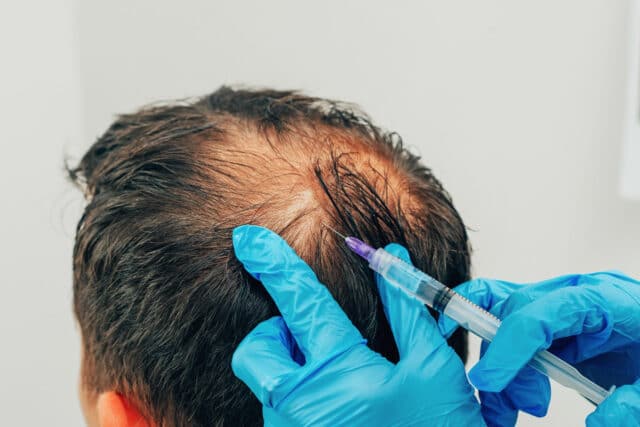When it comes to hair restoration, the Follicular Unit Transplantation (FUT) method has become a cornerstone in combating hair loss. Understanding the science behind this revolutionary procedure not only demystifies the process but also provides insights into why so many individuals are opting for it. This article delves into the technicalities and benefits of FUT hair transplants, particularly through the lens of leading practices in the UK. Whether you’re considering a transplant or simply curious, the insights shared will illuminate the journey from hair loss to regrowth.
From extracting donor hair to the art of implantation, each step is designed to ensure natural-looking results. Let’s explore the detailed science behind each stage of a FUT hair transplant and discover how it promises a fuller, more confident you.
What is the scientific process behind FUT hair transplants?
Follicular Unit Transplantation (FUT), commonly known as the strip method, is a surgical hair restoration technique that involves the transplantation of hair follicles from a donor site to a recipient site. The scientific process behind FUT is rooted in the understanding of hair follicle biology and the natural grouping of hair in follicular units, which typically contain one to four hairs.
The procedure begins with the identification of a suitable donor area, usually at the back or sides of the scalp, where hair is genetically resistant to balding. This area is selected because the hair follicles here are less affected by dihydrotestosterone (DHT), the hormone responsible for androgenetic alopecia, or male-pattern baldness.
Once the donor area is identified, a strip of scalp tissue is surgically removed. This strip is typically 1 to 1.5 cm wide and can vary in length depending on the number of grafts required. The strip is removed with precision to minimise damage to the surrounding tissues and ensure a high survival rate of the hair follicles.
After the strip is excised, the donor area is sutured closed, leaving a linear scar that is usually concealed by the surrounding hair. The excised strip is then meticulously dissected under a microscope into individual follicular units. This step is crucial as it ensures that each follicular unit is intact and viable for transplantation.
The dissected follicular units are then carefully implanted into tiny incisions made in the recipient area. The angle, depth, and distribution of these incisions are strategically planned to mimic the natural hair growth pattern, ensuring a natural-looking result. This meticulous placement is essential for achieving optimal density and aesthetic outcomes.
Throughout the process, maintaining the viability of the hair follicles is paramount. The follicles are kept in a specialised solution to preserve their health and increase the likelihood of successful transplantation. The entire procedure requires a high level of skill and precision, as the survival and growth of the transplanted hair depend on the careful handling of the follicular units.
Post-surgery, the transplanted hair enters a resting phase before new growth begins, typically within three to four months. The newly transplanted hair will continue to grow naturally, blending seamlessly with the existing hair. The scientific understanding of hair growth cycles and follicular unit dynamics is fundamental to the success of FUT hair transplants.
How do UK-Hair Transplant approach FUT hair transplant procedures?
During a Follicular Unit Transplantation (FUT) procedure, a strip of skin containing hair follicles is removed from the donor area — typically the back or sides of the head — where hair grows abundantly and is most resistant to balding. This is followed by a meticulous process, where skilled technicians dissect the donor strip into individual follicular units, which can include one to four hairs each. As one of the proven techniques used in hair transplants London clinics, FUT remains a popular choice for patients seeking fuller, natural-looking results.
The placement of these units is crucial. Surgeons create tiny incisions in the recipient site, planning the pattern, density and direction in which the hairs will grow. This precise placement is pivotal to achieving natural-looking results, ensuring the hair blends seamlessly with the existing strands. This meticulous orchestration of biological detail forms the cornerstone of FUT procedure’s success.
FUT is a tried-and-true method embraced by UK-Hair Transplants for its effectiveness and lasting results. Its reliance on nature’s engineering – the follicular unit – underscores the scientific sophistication behind it. However, like any surgical procedure, it carries certain risks such as scarring, infection, or unexpected results. Yet, when performed by skilled professionals, these risks are minimised.
Understanding these intricate steps and the science of follicle behaviour can offer a deeper appreciation of this transformative procedure, revealing why FUT remains a popular choice among those seeking a permanent solution to hair loss. By leveraging cutting-edge technology, UK-Hair Transplants provide their clients not just with a service, but with renewed confidence.
What are the latest advancements in FUT hair transplant technology?
The scientific process behind FUT (Follicular Unit Transplantation) hair transplants involves several meticulously planned stages. At its core, FUT leverages the natural grouping of hair follicles to create a seamless and natural appearance. It begins with the removal of a thin strip of scalp, typically from the back of the head, where hair growth is more robust and less prone to balding. This section is then dissected under high-powered microscopes into individual follicular units. Each unit might contain one to four hair follicles, which are then carefully transplanted into the patient’s balding areas.
But there’s more complexity to the process than meets the eye. It’s not merely about moving hair from one place to another; the placement and angling of each follicular unit are crucial. Surgeons need a keen understanding of hair growth patterns to ensure that the transplanted hair integrates flawlessly with the surrounding natural hair. The meticulous dissection and careful placement minimise damage to the follicles, maximising survival rates and promoting optimal regrowth.
Understanding this science is key to appreciating how FUT can provide a long-term solution to hair loss. With expertise honed over years, UK-Hair Transplants adopt a personalised approach to ensure each client receives a treatment tailored specifically to their unique hair pattern and density needs, ensuring not just graft survival, but also a naturally appealing outcome. This dedication to scientific precision is what makes FUT a reliable and popular choice for many seeking to restore a fuller head of hair.
How does FUT compare to other hair transplant methods in the UK?
When contemplating hair restoration, you might wonder how Follicular Unit Transplantation (FUT) measures up against other available methods, specifically in the UK. Well, it’s a matter of understanding distinct advantages and a few drawbacks of each method.
FUT vs. FUE: One of the primary alternatives to FUT is the Follicular Unit Extraction (FUE) technique. Both methods have their proponents, each with unique benefits. While FUT involves removing a strip of scalp from which individual hair follicles are gleaned, FUE extracts individual follicles directly from the donor area. FUT tends to be the preferred choice for those seeking a larger quantity of grafts in one session. On the other hand, FUE might appeal to individuals concerned about a linear scar, as its extraction points typically leave less noticeable scarring.
Considerations: In deciding between FUT and other options like FUE, personal preference plays a pivotal role alongside clinical advice. Factors such as the desired outcome, available donor hair, and long-term goals are crucial. Consultation with a seasoned surgeon will help tailor the method to your unique situation.
Geographical Impact: Its worth noting that the choice might be influenced by the location as well. In the UK, both FUT and FUE are widely adopted, but you will find that different clinics may specialise in one over the other.
Ultimately, each method’s effectiveness and suitability depend on your specific needs, and what you’re hoping to achieve in your hair restoration journey. Thorough research and professional insights remain invaluable in making the right choice for successful hair restoration.
Final Thoughts
To sum up, FUT hair transplant stands as a reliable and sophisticated solution for individuals seeking to address hair loss concerns. By blending scientific precision with innovative technology, UK-Hair Transplants ensures that each procedure is not just effective but also tailored to the unique needs of every client. As advancements continue to emerge, it becomes vital to stay informed, ensuring you make the best choice for your hair restoration journey. Should you have any questions or wish to explore hair transplant options further, reaching out to industry professionals can provide clarity and guidance. Taking the first step towards regaining confidence doesn’t have to be daunting — armed with knowledge, you are empowered to make the best decision for your future hair health.
If you’re considering a hair transplant, understanding the science is just the beginning. Connect with UK-Hair Transplants to explore your options, get personalised advice, and embark on a journey towards regaining your confidence. Contact us today to schedule a consultation and take the first step towards a fuller head of hair.


